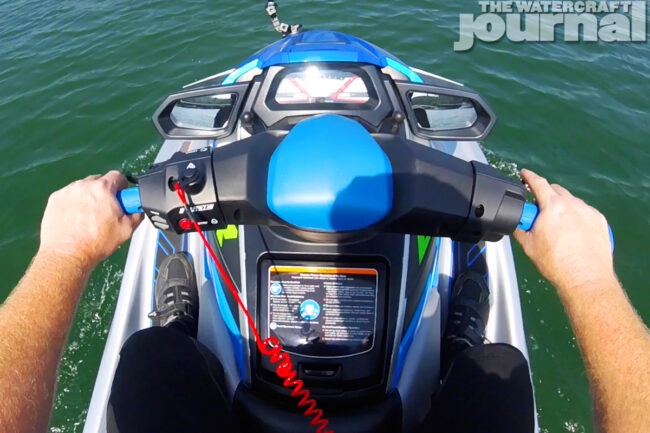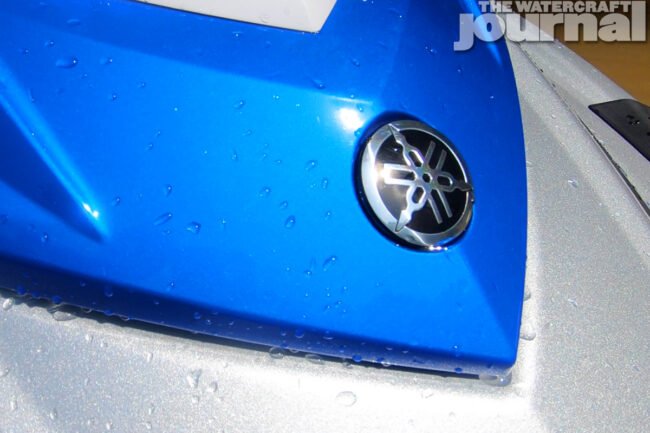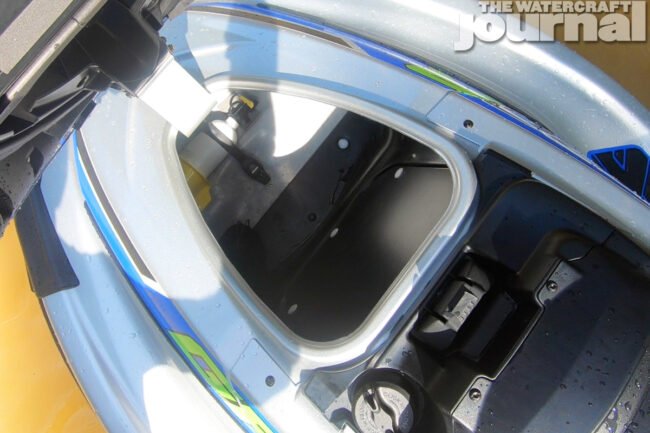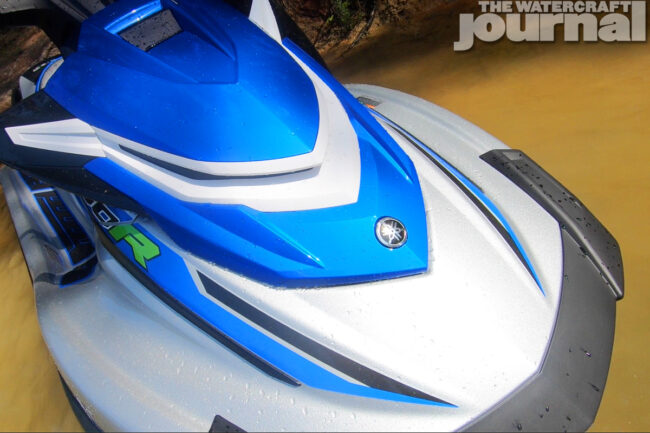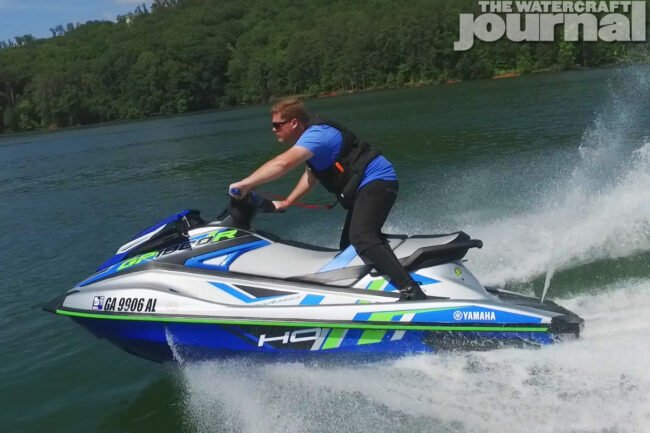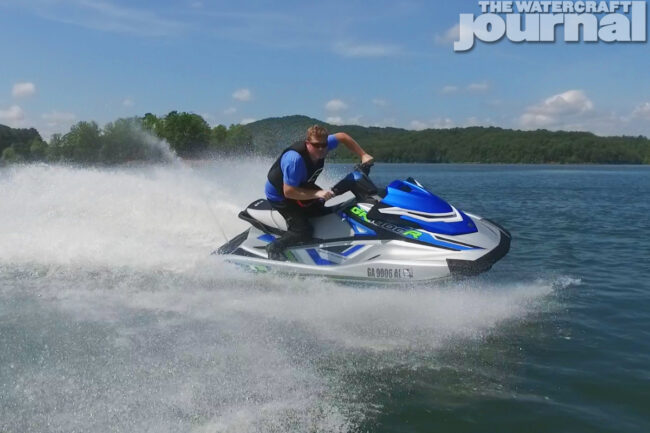For the 2020 model year, Yamaha offered few changes to its lineup of WaveRunners since frankly, little to no changes were required. One unique decision though was made to how it branded its performance Recreation-sized runabouts; namely, the supercharged GP1800R and VXR.
Both machines ride on the same hull design and deck shape (which is also shared with the family-friendly VX model line). For 2019, Yamaha pushed the familiar resemblance further, and announced that both watercraft would be made from the same lightweight NanoXcel2 material, dropping the VXR’s weight by 30-pounds (to 739-pounds).
Equally, both the supercharged and naturally-aspirated variants employed the same aftermarket-inspired race-ready ride plates and top-loader intake grates, radically improving both rough water traction and initial acceleration.
This meant that besides some differing color variations, the central differences between the GP1800R and the VXR would be the use of the Super Vortex High Output supercharged-and-intercooled engine and 160mm 8-vane jet pump, or the naturally-aspirated High Output and slightly smaller 155mm pump.
For 2020, the change to the VXR would be strictly topical, as it would also be known as a GP1800R, like its supercharged sibling. But this year, the two models would be distinguished by their respective powertrain. The supercharged-and-intercooled model was rechristened the GP1800R SVHO and the VXR was now known as the GP1800R HO (or High Output).
Albeit tremendously confusing for those already familiar with the two units, and quite a mouthful for those new to the Yamaha WaveRunner catalog, sales for the GP1800R HO haven’t wavered. The fuel consumption-friendly 1,812cc four-cylinder 4-stroke provides plenty of horsepower (180 of ’em) to propel this entry-level performance model to a GPS-tracked sustained speed of 66.2mph – on pace with other brand’s supercharged machines.
Offered in either Azure Blue and Silver, or Black and Carbon; the 2020 GP1800R HO is identically-equipped as its race-winning sibling, with responsive electric trim toggles on the driver’s left hand side of the pistol grip-molded handle bars. Adjusting the trim alters the watercraft’s attitude on the water, pre-loading the nose downward for tight cornering, or lifting the bow to quickly slice through wind-blown lake chop with ease.
Equally, the GP1800R HO comes equipped (as a standard safety feature) with Yamaha’s dual-throttle RiDE system, a very apt and capable on-water braking-and-reverse system. Whether coming to a complete stop from a wide-open-throttle sprint, or simply backing off of the trailer or into a tight dock space, RiDE uses intuitive throttle control to help the driver safely and smartly maneuver the WaveRunner in ways that inspire confidence in even the most novice pilots.
Due to its racing pedigree, the GP1800R HO is equipped with a high bolstered, thickly padded seat designed to position the driver slightly forward in the saddle. This position is designed to place the rider at attention, with their shoulders closer to the fixed-position handlebars (sorry, tilt steering isn’t available on these models).
Speed-hungry riders will find the GP1800R HO’s throttle and steering response lightning quick and incredibly precise. Simply flick the bars and vice the fly-by-wire throttle where you want to go, and WHAM! you’ll be there before you know it. Whether carving glass or rocketing over cresting waves, Yamaha’s hull shape has proven itself one of the best in the segment.
Storage capacity is moderate at 24.6-gallons, and is spread throughout the GP1800R HO’s 131.9-inch length; most of the cargo room resides in the bow, while a near-gallon sized glove box can hold two water bottles, and a watertight tub with a screw-top lid is found hidden under the rear passenger’s seat.
The hood opens on an aluminum hinge, locking upright on a final notch. There’s no spring or gas-powered strut like on the full-sized FX series models, so make sure to secure the hood vertical before letting go. Beneath it is the locking gas cap, just before the dashboard, well within reach of the driver for easy refueling.
And despite being a performance model, Yamaha also includes the padded, folding swim step off of the rear platform as standard equipment as well. The rear deck and footwells are covered in custom two-tone CNC-cut Hydro-Turf traction mats matching the textured and grippy cut-and-sew style seat mentioned earlier.
On the water, the GP1800R HO is lightweight and nimble without feeling thin or flimsy. There are no rattles or flapping plastics to give you the impression of a cheaply-built machine. Its tight tolerances give it a solid appearance and quality aesthetic.
As we’ve stated in previous reviews though, NanoXcel2 is nearly 30-percent thinner than Yamaha’s standard NanoXcel material. This means that while durability is high thanks to the proprietary nano-clay molecular bond, the GP1800R HO will not soak up the bumps and chatter that comes from streaking across the water.
Think of it like the low profile performance tires of a sports car being able to feel the paint strips painted on the road. A high performance machine is going to communicate the driving surface better than a cushier, more insulated model. This kind of road handling is what you’re paying for.
And handle is does in spades. The GP1800R HO has earned its stripes on the race course, and is the preferred weapon of choice in its class. Whether catching air offshore, or snapping hairpin turns on the buoy course, adrenaline junkies and professional racers alike have chosen the GP1800R HO above all others.
And for those of us who aren’t strapping on a helmet on the weekends, the GP1800R HO serves just as well as a family-fun recreation craft that can tow the kids on a raft (thanks to a stainless steel tow eye on the back), a long-distance cruiser (thanks in large part to its stellar fuel mileage and 18.5-gallon fuel tank), or a fun hot rod for dad and the boys to fool around on.
Priced at $12,299, the MSRP for the 2020 GP1800R HO has crept up in price over the years, but that is due almost entirely to rising demand. Yamaha dealers worldwide sell out of these units nearly as fast as they do the SVHO-powered variant – so if you’re looking at picking one up, you’re gonna have to act quick.


















